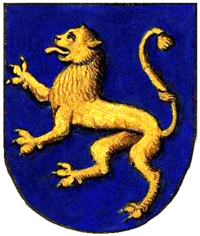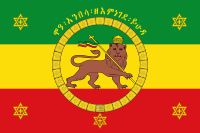Lion of Judah
 From Wikipedia - Reading time: 7 min
From Wikipedia - Reading time: 7 min
This article needs additional citations for verification. (May 2022) |

The Lion of Judah (Hebrew: אריה יהודה, Aryeh Yehudah) is a Jewish national and cultural symbol, traditionally regarded as the symbol of the tribe of Judah. The association between the Judahites and the lion can first be found in the blessing given by Jacob to his fourth son, Judah, in the Book of Genesis of the Hebrew Bible.[1]
It is also mentioned in the Book of Revelation of the New Testament as a term representing Jesus of Nazareth, according to Christian theology.[2] The Lion of Judah was also one of the titles used by Ethiopian emperors from the Solomonic dynasty.
History
[edit]Judaism
[edit]
The biblical Judah (in Hebrew: Yehuda) is the eponymous ancestor of the Tribe of Judah, which is traditionally symbolized by a lion. In Genesis, the patriarch Jacob ("Israel") gave that symbol to this tribe when he refers to his son Judah as a Gur Aryeh' גּוּר אַרְיֵה יְהוּדָה, "Young Lion" (Genesis 49:9) when blessing him.[3] In Jewish naming tradition the Hebrew name and the substitute name are often combined as a pair, as in this case. The Lion of Judah was used as a Jewish symbol for many years, and as Jerusalem was the capital of the Kingdom of Judah, in 1950 it was included in the Emblem of Jerusalem.[4][5]
Christianity
[edit]
The phrase appears in the New Testament in Revelation 5:5:
Then one of the elders said to me, "Do not weep. See, the Lion of the tribe of Judah, the Root of David, has conquered, so that he can open the scroll and its seven seals."
This is widely regarded as a reference to the Second Coming among Christians.[citation needed]
Many Christian organizations and ministries use the lion of Judah as their emblem or even as their names.[citation needed]
Ethiopia
[edit]
It was depicted on a map of the Upper Nile published in 1683 by the Italian Jobi Ludolfi describing the Lion of Judah symbol as the royal insignia of the Ethiopian Empire. The Solomonic dynasty of Ethiopia claims to have its patrilineal origin in the Israelite Royal House of Judah. The Lion of Judah served as the hereditary title of the Solomonic Ethiopian emperors and nobles including Sabagadis Woldu, Kenfu Hailu, Wube Haile Mariam, Tewodros II, Yohannes IV, Menelik, and Haile Selassie and was depicted on the flag of Ethiopia from 1897 to 1974. Due to its association with Haile Selassie, it continues to be an important symbol among members of the Rastafari movement.[6]
The Lion of Judah motif figured prominently on the old imperial flag, currency, stamps, etc. and may still be seen gracing the terrace of the capital as a national symbol. After the collapse of the Derg in 1990, a minor political party bearing the name Mo'a Anbessa' made its appearance.[citation needed]
Kebra Nagast
[edit]Ethiopia's history as recorded and elaborated in a 13th-century treatise, the Kebra Nagast, asserts descent from a retinue of Israelites who returned with Makeda, the Queen of Sheba from her visit to King Solomon in Jerusalem, by whom she had conceived the Solomonic dynasty's founder Menelik I. As Solomon was of the tribe of Judah, his son Menelik I would continue the line, which according to Ethiopian history was passed directly down from king to king until Emperor Haile Selassie I (ostensibly the 225th king from King David) was deposed in 1974.[7][8][9]
Both Christian and Jewish Ethiopian history have it that there were also immigrants of the Tribes of Dan and Judah that accompanied Makeda back from her visit to Solomon; hence the Ge'ez motto Mo`a 'Anbessa Ze'imnegede Yihuda ("The Lion of Judah has conquered"), included among the titles of the Emperor throughout the Solomonic Dynasty.[citation needed]
Rastafari
[edit]The Lion of Judah is a prominent symbol in the Rastafari movement. It represents Emperor Haile Selassie I as well as being a symbol of strength, kingship, pride and African sovereignty.[10] Rastafari consider the mention of "The Lion of Judah" in Genesis 49:9 and Revelation 5:5 of the Bible to refer to Emperor Haile Selassie I. Rastafari hail Haile Selassie I with the titles "King of kings, lord of lords, conquering Lion of Judah, elect of God, the light of the world".[11]
The Lion of Judah 1981
[edit]In 1981 Lutz Becker published archival film footage showing the occupation of Ethiopia by Fascist Italy in the documentary film The Lion of Judah. The archival footage shows the illegal combat with mustard gas.[12]
In literature
[edit]Inspired by the Lion of Judah, C. S. Lewis used a lion named Aslan to represent Jesus in The Chronicles of Narnia.[13][14][15][16]
See also
[edit]- Monument to the Lion of Judah, a historic statue in Ethiopia
References
[edit]- ^ "Genesis 49:9". Biblos. Archived from the original on 17 February 2015. Retrieved 1 December 2014.
- ^ "Revelation 5:5". Bible Study Tools. Archived from the original on 19 January 2015. Retrieved 1 December 2014.
- ^ Genesis 49:9
- ^ על מקורותיו של האריה הירושלמי
- ^ אריות בירושלים
- ^ "Rastafarians". flagspot.net. Archived from the original on 2015-09-29.
- ^ "Archived copy" (PDF). Archived (PDF) from the original on 2016-11-30. Retrieved 2017-01-06.
{{cite web}}: CS1 maint: archived copy as title (link) - ^ "Debate Central - Since 1994". Archived from the original on 2017-05-21. Retrieved 2017-01-06.
- ^ Adem, Seifudein (2012). "'The Lion of Judah in the New World: Emperor Haile Selassie of Ethiopia and the Shaping of Americans' Attitude Toward Africa' by Vestal T. Santa Barbara, CA: Praeger, 2011. Pp. 231, $44.95 (hbk)". The Journal of Modern African Studies. 50 (3): 541–542. doi:10.1017/S0022278X12000286. S2CID 155064698. Archived from the original on 2017-01-07 – via Cambridge Core.
- ^ Barnett, Michael; Onuora, Adwoa Ntozake (2014). "Rastafari as Afrocentrically Based Discourse and Spiritual Expression". Rastafari in the New Millennium: A Rastafari Reader. Syracuse University Press.
- ^ Chislom, Clinton (1998). "The Rasta-Selassie-Ethiopian Connections". In Murrel, Nathaniel Samuel; et al. (eds.). Chanting Down Babylon: The Rastafari Reader. Temple University Press. p. 171. ISBN 9781566395847. Archived from the original on 2016-09-18.
- ^ Caterina Albano (2016). Memory, Forgetting and the Moving Image. Palgrave Macmillan UK. p. 187. ISBN 9781137365880.
- ^ "Liam Neeson says Narnia's Aslan could be Muhammed | Christian News on Christian Today". Christiantoday.com. 2010-12-09. Retrieved 2015-03-05.
- ^ Hooper, Walter (1998-06-23). C. S. Lewis: A Complete Guide to His Life & Works – Google Books. Zondervan. ISBN 9780060638801. Retrieved 2015-03-05.
- ^ "NarniaWeb Community Forums: View topic – Allegorical Aslan – C.S. Lewis Quote". Forum.narniaweb.com. Archived from the original on 2014-05-24. Retrieved 2015-03-05.
- ^ "C S Lewis Letter Testifies Narnia's Lion as Christ". Christian News on Christian Today christiantoday.com. 2005-12-07. Retrieved 2015-03-05.
 KSF
KSF